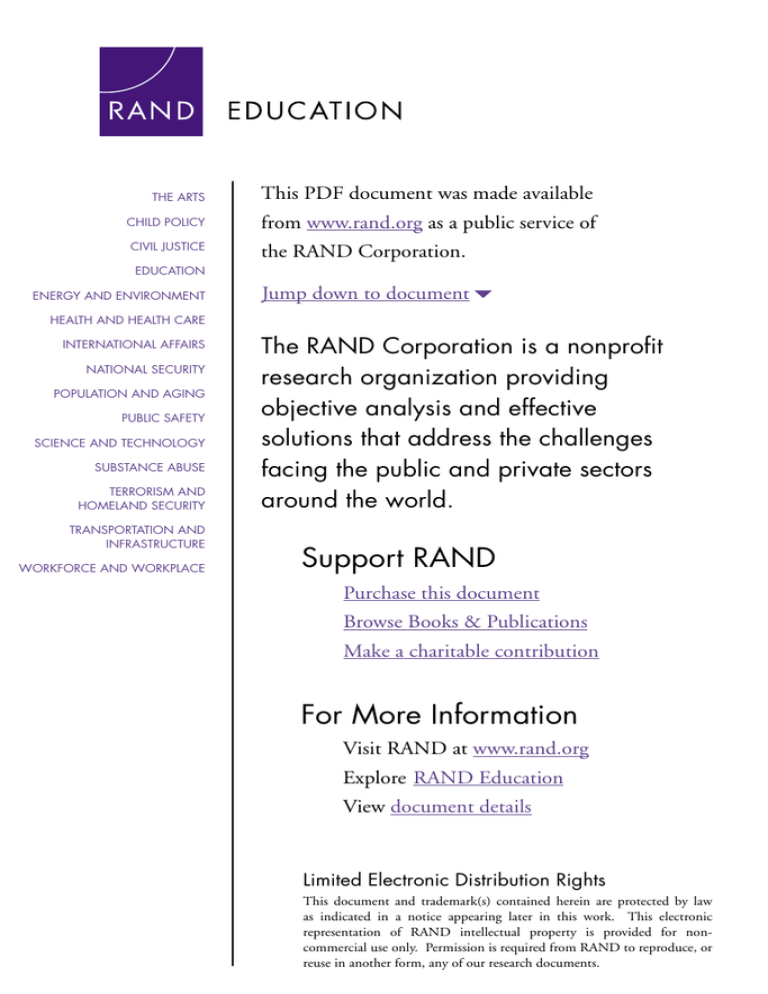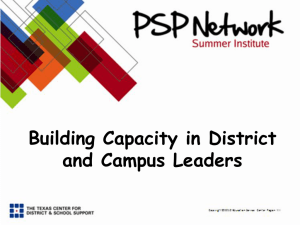
THE ARTS
This PDF document was made available
CHILD POLICY
from www.rand.org as a public service of
CIVIL JUSTICE
the RAND Corporation.
EDUCATION
ENERGY AND ENVIRONMENT
Jump down to document6
HEALTH AND HEALTH CARE
INTERNATIONAL AFFAIRS
NATIONAL SECURITY
POPULATION AND AGING
PUBLIC SAFETY
SCIENCE AND TECHNOLOGY
SUBSTANCE ABUSE
TERRORISM AND
HOMELAND SECURITY
TRANSPORTATION AND
INFRASTRUCTURE
WORKFORCE AND WORKPLACE
The RAND Corporation is a nonprofit
research organization providing
objective analysis and effective
solutions that address the challenges
facing the public and private sectors
around the world.
Support RAND
Purchase this document
Browse Books & Publications
Make a charitable contribution
For More Information
Visit RAND at www.rand.org
Explore RAND Education
View document details
Limited Electronic Distribution Rights
This document and trademark(s) contained herein are protected by law
as indicated in a notice appearing later in this work. This electronic
representation of RAND intellectual property is provided for noncommercial use only. Permission is required from RAND to reproduce, or
reuse in another form, any of our research documents.
This product is part of the RAND Corporation monograph series.
RAND monographs present major research findings that address the
challenges facing the public and private sectors. All RAND monographs undergo rigorous peer review to ensure high standards for
research quality and objectivity.
The Role of Districts in
Fostering Instructional
Improvement
Lessons from Three Urban Districts
Partnered with the Institute for Learning
Julie A. Marsh, Kerri A. Kerr, Gina S. Ikemoto, Hilary Darilek,
Marika Suttorp, Ron W. Zimmer, Heather Barney
Supported by The William and Flora Hewlett Foundation
The research described in this report was conducted within RAND
Education and supported by The William and Flora Hewlett
Foundation.
Library of Congress Cataloging-in-Publication Data
The role of districts in fostering instructional improvement : lessons from three urban
districts partnered with the Institute for Learning / Julie A. Marsh ... [et al.].
p. cm.
“MG-361.”
Includes bibliographical references.
ISBN 0-8330-3853-2 (pbk. : alk. paper)
1. School improvement programs—United States—Case studies. 2. Instructional
systems—United States—Case studies. 3. School districts—United States—Case
studies. 4. Educational change—United States—Case studies. I. Marsh, Julie A. II.
Institute for Learning.
LB2822.82.R64 2005
379.1'5350973—dc22
2005025509
Cover photo: Media Bakery at www.mediabakery.com
The RAND Corporation is a nonprofit research organization providing
objective analysis and effective solutions that address the challenges
facing the public and private sectors around the world. R AND’s
publications do not necessarily reflect the opinions of its research clients
and sponsors.
R® is a registered trademark.
© Copyright 2005 RAND Corporation
All rights reserved. No part of this book may be reproduced in any
form by any electronic or mechanical means (including photocopying,
recording, or information storage and retrieval) without permission in
writing from RAND.
Published 2005 by the RAND Corporation
1776 Main Street, P.O. Box 2138, Santa Monica, CA 90407-2138
1200 South Hayes Street, Arlington, VA 22202-5050
201 North Craig Street, Suite 202, Pittsburgh, PA 15213-1516
RAND URL: http://www.rand.org/
To order RAND documents or to obtain additional information, contact
Distribution Services: Telephone: (310) 451-7002;
Fax: (310) 451-6915; Email: order@rand.org
Summary
Improving school systems is critical to bridging the achievement gap
between students of different racial and socioeconomic backgrounds
and to achieving the goals of the No Child Left Behind Act (NCLB).
In fall 2002, the RAND Corporation initiated a formative assessment
of three urban districts’ efforts to improve instructional quality and
school performance. The study explored ways to improve teaching
and learning in urban school districts. It also examined the contributions of one intermediary organization, the Institute for Learning
(IFL), to efforts to introduce systemic change in the three districts.
The study sought to answer four broad questions:
• What strategies did districts employ to promote instructional
improvement? How did these strategies work?
• What were the constraints and enablers of district instructional
improvement efforts?
• What was the impact of the IFL? What were the constraints and
enablers of the district-IFL partnerships?
• What are the implications for district instructional improvement
and district-intermediary partnerships?
xvii
xviii
The Role of Districts in Fostering Instructional Improvement
Methods
We used a comparative case study design and mixed methods to answer these questions. Districts were selected for experience working
with the IFL (more than three years) and for variation in district size,
union environment, and state context. We collected and analyzed
data from extensive field interviews and focus groups conducted over
a two-year period; from RAND-developed surveys of elementary,
middle, and high school principals and teachers; from district and
IFL documents; and from demographic and student achievement databases.
Findings
Our evidence yielded the following findings.
District Instructional Improvement Strategies
In the three districts, instructional reform efforts revolved around
four common areas of focus: building the instructional leadership
skills of principals; supporting the professional learning of teachers,
with a particular focus on school-based coaching; providing greater
specification of and support for standards-aligned curriculum; and
promoting the use of data to guide instructional decisions. While all
districts pursued strategies within each area, each tended to focus on
two key areas to change the system. In addition, districts had varying
degrees of success in attaining the intermediate reform goals (i.e.,
outcomes expected to ultimately contribute to improved teaching and
learning). Our findings in the four areas of reform are as follows.
Instructional Leadership. All districts attempted to increase
principals’ instructional leadership capacity, giving principals professional development and expecting principals’ supervisors (who typically had titles such as area or assistant superintendent) to focus
school visits and meetings with principals on matters related to improving instruction.
Summary
xix
Despite a relatively consistent focus on instructional leadership,
principals varied greatly in the extent to which they acted as instructional
leaders. While our data do not definitively explain this variation, several factors enabled district efforts: high-quality professional development and supportive supervisors who helped principals develop
instructional leadership skills and implement them daily. Other factors limited this ability: lack of time and lack of credibility—that is,
teachers did not view their principals as knowledgeable about instruction.
School-Based Coaching. Two districts invested in school-based
instructional coaches as a means of providing ongoing, job-embedded
professional development for teachers, but each implemented a different model. Although both models were intended to build the instructional capacity of schools and support district initiatives, teachers
tended to prefer the more flexible, school-centered approach to coaching
rather than the relatively standardized curriculum-centered one. The
perceived value and effectiveness of coaches by teachers was greater
when (1) coaches tailored their work to school and teacher needs, (2)
coaches advised teachers about instruction, (3) time was available to
meet with teachers, and (4) roles were clearly defined.
Curriculum Specification. All districts developed and implemented curriculum guidance documents that were intended to improve alignment of instruction with state standards and assessments
and to increase consistency of instruction across classrooms and
schools by specifying districtwide guidelines for the scope, pacing,
and content of curriculum. Two districts invested significant resources into developing and monitoring teachers’ use of the documents.
While district and school staff generally viewed the curriculum
guides as useful for planning, promoting consistency of instruction, and
helping principals observe and monitor teachers, teachers reported a limited effect on pedagogy. That is, teachers reported that guides influenced “when” and “what” they taught, but they did not make major
shifts in “how” they taught the curriculum. Teachers were apt to
value and use the guides when they perceived them to be aligned with
state tests, received them in a timely manner, and participated in the
xx
The Role of Districts in Fostering Instructional Improvement
development process. However, many teachers in all districts described the pacing and content of the guides as conflicting with their
need to tailor instruction to individual students.
Data Use. The study districts invested to varying degrees in
multiple strategies promoting the use of data to guide instructional
decisions, such as providing professional development on how to interpret test results and encouraging structured reviews of student
work. However, two districts focused much more on use of data. One
emphasized the school improvement planning (SIP) process. The second district focused on interim assessments, designed to provide an
“early warning system on progress being made” toward meeting state
standards.
Teachers and principals in both districts generally found the various
sources of data useful and reported using them regularly to identify areas
of weakness and to guide instructional decisions.. Principals and teachers
in the district that focused on the SIP process, however, described the
process as overly labor-intensive. Furthermore, teachers in the district
that focused on interim assessments were less enthusiastic about these
assessments than principals, preferring more timely, regular classroom
assessment data. The efforts of both districts to focus on data were
enabled by long-standing state accountability systems, accessibility
and timeliness of data, teachers’ views of the assessment results as
valid measures of students’ knowledge and ability, and the degree to
which school staff received training and support for analyzing and
interpreting data.
Constraints and Enablers of Instructional Improvement
Once district leaders had designed their reform strategies and put
them into place, a number of common factors affected districts’ success in bringing about the intermediate outcomes they intended for
each set of strategies. Taken as a whole, these factors led to several
cross-cutting findings:
• Although it was important for districts to implement comprehensive reform, they benefited from focusing on a small number of initiatives. While seemingly counter-intuitive, the com-
Summary
xxi
bination of comprehensiveness—a systemic approach, strategies
addressing all dimensions of instruction, and a dual focus on infrastructure and direct support—and focus on two key areas of
reform proved to be important for instructional reform in all
three districts.
• District and school capacity greatly affected reform efforts.
While focusing on a few priority initiatives may have helped
conserve limited resources to some extent, all districts nonetheless faced significant capacity gaps that hindered instructional
improvement. According to district and school staff across the
sites, capacity gaps that were most detrimental were insufficient
time (e.g., for planning, to act as instructional leaders), lack
and/or instability of fiscal or physical resources (e.g., instructional
materials, funding), and limited capacity of central office staff
(e.g., inadequate numbers, lack of expertise).
• The broader policy context created both enabling and constraining conditions for district reform. For example, some
union policies hindered reform in two districts, and state and
federal accountability policies shaped much of the districts’ work
with curriculum and data use.
• Districts’ success also was tied to several key dimensions and
characteristics of the policies they developed. District progress
at achieving intermediate instructional improvement goals
hinged in large part on the degree to which strategies
—were aligned and mutually supportive
—enabled multiple stakeholders to engage in reform
—balanced standardization and flexibility
—used local accountability policies to provide incentives
for meaningful change.
Overall, districts generally struggled to achieve these policy features, which might be better characterized as common challenges or
tensions that districts faced in achieving systemwide change.
xxii
The Role of Districts in Fostering Instructional Improvement
Effect of IFL on District Instructional Reform
Partnerships with the IFL contributed to district reform in all three
districts. In exchange for a fee, the IFL provided districts with a variety of resources, including on-site technical assistance from IFL resident fellows, opportunities to attend national meetings with other
partner districts, advice from IFL leaders, and access to research, materials, and other tools. The IFL did not present an intervention or
model for districts to implement as such but instead acted as a
“coach,” assisting districts with various aspects of instructional improvement appropriate to each local context.
In examining the IFL role in supporting district work in the four
areas of instructional reform, we found that the strongest reported
contributions of IFL were to systemwide efforts to build the instructional leadership of administrators. At all three sites, the IFL influenced the design and implementation of professional development
opportunities for principals and central office staff, frequently delivering monthly training sessions and providing supporting materials
that elucidated what it meant to be an instructional leader. According
to district and IFL leaders, the IFL’s contribution to other areas of
reform—data use, coaching, and curriculum specification—was not
as strong or as consistent across sites.
Overall, two findings emerged from our analysis of the IFL contributions to district reform.
1. District and school leaders reported that the IFL affected the
organizational culture, norms, and beliefs about instruction.
District leaders reported shifts in beliefs and norms around a set of
ideas emphasized in IFL materials, professional development, and
technical assistance. These included effort-based intelligence, twoway accountability, a focus on instruction and learning, the idea
that everyone is a learner, and instruction as a public endeavor.
2. The IFL was credited with helping develop the knowledge and
skills of central office and school administrators. The majority of
principals in all three districts reported that professional development opportunities organized by the IFL and the districts improved their skills as instructional leaders, deepened their
Summary
xxiii
knowledge about learning, and provided them with a common
language facilitating dialogue. Similarly, central office leaders and
staff reported that IFL staff pushed them to focus on instruction
and system-level structures and policies that enabled high-quality
instruction. They also reported that the IFL helped them become
more knowledgeable about instruction and more skilled at supervising and supporting principals.
Both of these reported effects address key challenges facing districts undertaking systemic reform—namely, a lack of alignment
among district initiatives and limited capacity to undertake reform.
By providing a common set of ideas concerning teaching and learning, the IFL may have helped districts build mutually supportive reform strategies around a common vision of high-quality instruction.
By enhancing principals’ and central office administrators’ knowledge
and skills, the IFL also may have helped build the overall capacity of
the district to lead instructional change across a system of schools.
Finally, several common factors appeared to influence IFL partnerships with the districts and its impact on them. The effect of the
IFL was particularly strong when
• district and school leaders (e.g., superintendent, mid-level managers, principals) bought into the IFL’s work
• IFL staff were viewed as trustworthy, credible, and having expertise that matched a particular district need
• the IFL offered practical tools to support implementation of
theoretical ideas.
In some cases, however, the IFL’s influence was constrained by
• the perception of IFL as a vendor brought in to provide particular services without much coordination and support from
district leaders
• the IFL’s limited capacity to support districts in all areas of
reform
• turnover within the districts and the IFL.
xxiv
The Role of Districts in Fostering Instructional Improvement
Lessons Learned
The experiences of these three urban districts and their partnerships
with the IFL provide evidence of promising results from systemwide
instructional improvement efforts, yet they also raise warnings for
districts and intermediary organizations about several important
challenges they might face when attempting similar reforms. Our case
studies also show that an intermediary organization can help districts
address persistent constraints on reform by building the capacity of
district staff to engage in instructional change and by facilitating policy alignment.
Lessons for Instructional Improvement
Based on the reform experiences of the three study districts, we offer
the following lessons learned:
• Investing in the professional development of central office staff
can enhance capacity to lead instructional reform.
• Instituting local accountability policies that create incentives for
meaningful change can promote implementation.
• Aligning and developing a comprehensive set of strategies can
reinforce overarching instructional improvement goals.
Lessons for District-Intermediary Partnerships
Although the specific characteristics of the IFL set it apart from some
other types of third-party organizations, its experiences in these three
districts nevertheless offer potentially useful insights for similar organizations as well as for districts considering similar partnerships. We
present the following observations:
• Buy-in and support from top-level leaders can affect partnership
viability.
• Preexisting reform initiatives and partnerships are important to
consider when forming new partnerships.
Summary
xxv
• The capacity of the intermediary organization and its alignment
with district needs can greatly affect partnership success.
• Practical tools that are perceived to be relevant and legitimate to
the district’s local context are needed.
• Multiple types of “scale-up” strategies can be relevant to systemwide change efforts.
• Defining and measuring partnership goals and progress may facilitate improvements and help sustain partnerships over time.
In the end, the experiences of these three urban districts and
their partnerships with the IFL provide encouraging results regarding
the role that districts and intermediary organizations can play in improving instruction, and valuable lessons about factors that constrain
and enable the implementation and impact of such efforts.




